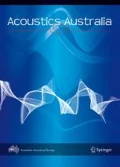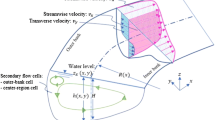Abstract
A cold eddy was detected east of Taiwan. The two-dimensional (2-D) eddy structure for the cold eddy was constructed with Argo data. Results show that the eddy structure follows that of an ellipsoid, where the largest anomaly occurs near the center at almost 400 m depth. The horizontal diameter was 200 km, and the vertical diameter was 500 m. The 2-D sound speed profile feature model for the cold eddy based on the Argo profiles was established with the EOF method. With the feature model, acoustic propagation through both a stationary eddy and a moving eddy was investigated. Results suggest that the presence of the cold eddy could push the convergence zone up to 4 km closer to the source, where it acts as a convex mirror to focus the energy. The movement of the eddy would affect the transmission loss of the first group ray arrivals by about 1 dB, the time delay by about 0.01 s, and the receiver angle by about 0.8° when the source and the receiver were at 300 m depth and the receiver was located 300 km away from the source.










Similar content being viewed by others
References
Levenson, C., Doblar, R.A.: Long range acoustic propagation through the Gulf Stream. J. Acoust. Soc. Am. 59(5), 1134–1141 (1976)
Spindel, R.C., Spiesberger, J.L.: Multipath variability due to the Gulf Stream. J. Acoust. Soc. Am. 69(4), 982–988 (1981)
Mellberg, L.E., Robinson, A.R., Botseas, G.: Modeled time variability of acoustic propagation through a Gulf Stream meander and eddies. J. Acoust. Soc. Am. 87(3), 1044–1054 (1990)
Abbot, P., Celuzza, S., Dyer, I., et al.: Effects of East China sea shallow-water environment on acoustic propagation. IEEE J. Ocean. Eng. 28(2), 192–211 (2003)
Luo, J., Badiey, M., Lin, Y.: Horizontal focusing/defocusing due to shallow water internal waves. J. Acoust. Soc. Am. 127(3), 1786 (2010). (SWARM)
Apel, J.R., Badiey, M., Chiu, C.S., et al.: An overview of the 1995 SWARM shallow-water internal wave acoustic scattering experiment. IEEE J. Ocean. Eng. 22(3), 465–500 (1997)
Worcester, P.F., Dzieciuch, M.A., Mercer, J.A., et al.: The North Pacific acoustic laboratory deep-water acoustic propagation experiments in the Philippine sea. J. Acoust. Soc. Am. 134(4), 3359–3375 (2012)
Chen, C., Lei, B., Ma, Y.L., et al.: Investigating sound speed profile assimilation: an experiment in the Philippine Sea[J]. Ocean Eng. 124, 135–140 (2016)
Chen, C., Yang, K., Duan, R., Ma, Y.: Acoustic propagation analysis with a sound speed feature model in the front area of Kuroshio extension. Appl. Ocean Res. 68, 1–10 (2017). https://doi.org/10.1016/j.apor.2017.08.001
Chen, C., Yang, K.D., Ma, Y.L., et al.: Comparison of surface duct energy leakage with bottom-bounce energy of close range propagation[J]. Chin. Phys. Lett. 33(10), 104302 (2016)
Gordon, A.L.: Interocean exchange of thermocline water. J. Geophys. Res. 91(91), 5037–5046 (1986). https://doi.org/10.1029/JC091iC04p05037
CATOC Consortium: Ocean climate change: comparison of acoustic tomography, satellite altimetry, and modeling. Science 281(5381), 1327–1332 (1998)
Suga, T., Takei, Y., Hanawa, K.: Thermostad distribution in the North Pacific subtropical gyre: the central mode water and the subtropical mode water. J. Phys. Oceanogr. 27, 140–152 (1997). https://doi.org/10.1175/1520-0485(1997)027%3c0140:TDITNP%3e2.0.CO;2
Bingham, F.M., Suga, T.: Distributions of mixed layer properties in North Pacific water mass formation areas: comparison of Argo floats and World Ocean Atlas 2001. Ocean Sci. 3(1), 61–70 (2006). https://doi.org/10.5194/os-2-61-2006
Ohno, Y., Iwasaka, N., Kobashi, F., et al.: Mixed layer depth climatology of the North Pacific based on Argo observations. J. Oceanogr. 65(1), 1–16 (2009)
Li, J., Yang, K.D., Lei, B., et al.: Research on the temporal-spatial distributions and the physical mechanisms for the sound speed profiles in north-central Indian Ocean. Acta Phys. Sin. 61(8), 282–299 (2012). (in Chinese)
Jayne, S.R., Hogg, N.G., Waterman, S.N., et al.: The Kuroshio extension and its recirculation gyres, Deep Sea Res. Part I Oceanogr. Res. Pap. 56(12), 2088–2099 (2009)
Taguchi, B., Qiu, B., Nonaka, M., et al.: Decadal variability of the Kuroshio extension: mesoscale eddies and recirculations. Ocean Dyn. 60(3), 673–691 (2010)
Qiu, B., Chen, S.: Eddy-induced heat transport in the subtropical North Pacific from Argo, TMI, and altimetry measurements[J]. J. Phys. Oceanogr. 35(4), 458–473 (2005)
Wang, G., Su, J., Chu, P.C.: Mesoscale eddies in the South China Sea observed with altimeter data[J]. Geophys. Res. Lett. 30(21), OCE 6-1 (2003)
Chelton, D.B., Schlax, M.G., Samelson, R.M., et al.: Global observations of large oceanic eddies[J]. Geophys. Res. Lett. 34(15), 87–101 (2007)
Chaigneau, A., Gizolme, A., Grados, C.: Mesoscale eddies off Peru in altimeter records: identification algorithms and eddy spatio-temporal patterns[J]. Prog. Oceanogr. 79(s 2–4), 106–119 (2008)
Chaigneau, A., Texier, M.L., Eldin, G., et al.: Vertical structure of mesoscale eddies in the eastern South Pacific Ocean: a composite analysis from altimetry and Argo profiling floats[J]. J. Geophys. Res. Atmos. 116(C11), 476–487 (2011)
Zhang, Z., Zhang, Y., Wang, W., et al.: Universal structure of mesoscale eddies in the ocean[J]. Geophys. Res. Lett. 40(14), 3677–3681 (2013)
Lovett, J.R.: Merged seawater sound-speed equations[J]. J. Acoust. Soc. Am. 63(63), 1713–1718 (1978)
Du, B.L., Song, X.J.: A method applying empirical orthogonal function analysis to predict the sea surface temperature[J]. Acta Oceanol. Sin. 3(1), 14–27 (1981)
Porter, M.B., Bucker, H.P.: Gaussian beam tracing for computing ocean acoustic fields[J]. J. Acoust. Soc. Am. 82(4), 1349–1359 (1987)
Acknowledgements
The sea surface height data were made available on the AVISO web (ftp://ftp.aviso.altimetry.fr/). The Argo URL (http://argo.jcommops.org) data were made available by the China Argo real-time data center on the Web.
Author information
Authors and Affiliations
Corresponding author
Additional information
Publisher’s Note
Springer Nature remains neutral with regard to jurisdictional claims in published maps and institutional affiliations.
Rights and permissions
About this article
Cite this article
Chen, C., Gao, Y., Yan, F. et al. Delving into the Two-Dimensional Structure of a Cold Eddy East of Taiwan and Its Impact on Acoustic Propagation. Acoust Aust 47, 185–193 (2019). https://doi.org/10.1007/s40857-019-00160-7
Received:
Accepted:
Published:
Issue Date:
DOI: https://doi.org/10.1007/s40857-019-00160-7




